Response bias can undermine the accuracy and reliability of your survey data, leading to flawed insights and poor decision-making. But with the right strategies, you can minimize its impact and unlock the true power of your surveys.
In this guide, we'll explore what response bias is, and dive into proven techniques to avoid it, and ensure your survey results are as accurate as possible. From crafting neutral questions to using advanced statistical methods, you'll learn how to:
Identify and understand different types of response bias
Write questions that minimize bias and maximize data quality
Motivate respondents to provide honest and thoughtful answers
Distinguish between response bias and nonresponse bias
Analyze and interpret survey results with response bias in mind
Whether you're a seasoned researcher or just starting out, this guide will give you the tools and knowledge you need to minimize response bias and get the most value from your surveys. Let's get started!
What is Response Bias?
Response bias refers to a systematic error in survey research that occurs when respondents provide answers that are influenced by factors other than their true beliefs, attitudes, or experiences. This can lead to inaccurate results and flawed decision-making based on the collected data. To ensure the reliability and validity of survey findings, it is essential to identify and understand the various types of response bias that can occur in survey design.
Types of Response Bias: Understanding Bias in Survey Design
There are many types of response bias that can work their way into your survey results, leading to inaccurate results and flawed decision-making
Below are the most common types of response bias, and with tips to minimize their effects on your survey data.
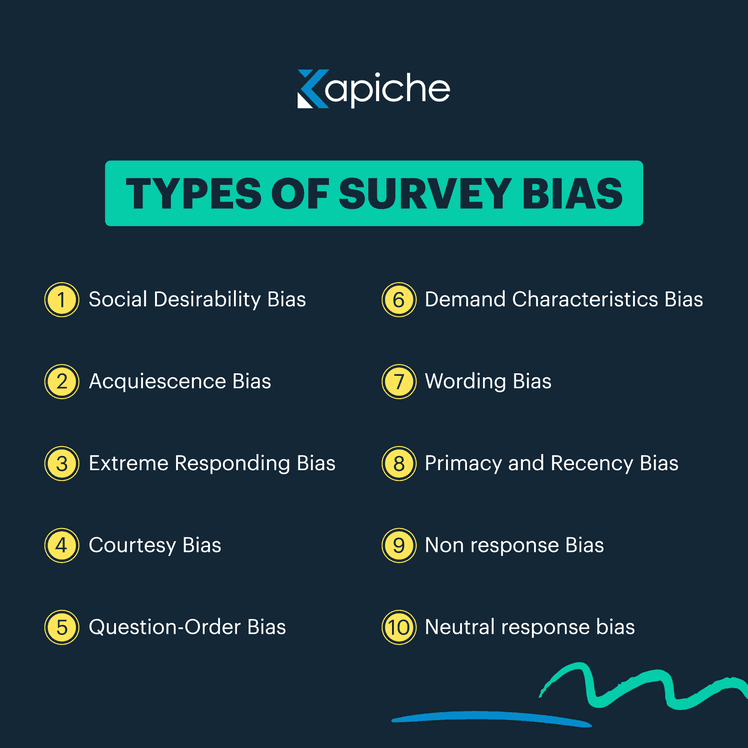
1) Social Desirability Bias
Social desirability bias is a type of response bias that occurs when respondents answer questions in a way that presents them favorably to others. This bias arises from the human tendency to want to be perceived positively by others, and to conform to social norms and expectations.
Social Desirability Bias Example
Respondents may underreport their alcohol consumption or overstate their charitable donations to appear more socially acceptable. This can lead to inaccurate data and misrepresentation of the true attitudes and behaviors of the population being studied.
Detecting Social Desirability Bias
To detect social desirability bias, researchers can:
Include questions that have both socially desirable and undesirable response options
Use indirect questioning techniques, such as asking about the behavior of others rather than the respondent's own behavior
Employ social desirability scales, such as the Marlowe-Crowne Social Desirability Scale, to measure the respondent's tendency to provide socially desirable answers
Here's an example of a question susceptible to social desirability bias, and a rephrased version aimed at minimizing this response bias.
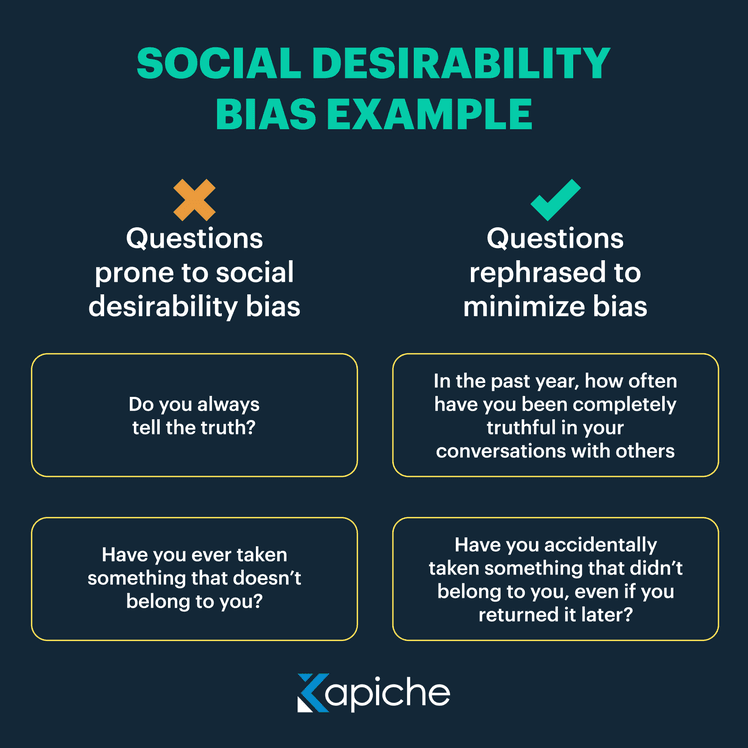
2) Acquiescence Bias
Acquiescence bias, also known as agreement bias, is a type of response bias where respondents tend to agree with statements regardless of their content. This bias can occur when respondents feel pressured to provide an answer, even if they don't have a strong opinion on the topic, or when they want to avoid appearing uncooperative or disagreeable.
Acquiescence Bias Example
For instance, a respondent may answer "yes" to contradictory questions, such as "I enjoy spending time with friends" and "I prefer to be alone," due to acquiescence bias.
Minimizing Acquiescence Bias
To minimize acquiescence bias, researchers can:
Select the right scales: Use balanced scales that include both positively and negatively worded items
Evaluate question structure: Avoid leading or loaded questions that suggest a particular answer
Provide neutral options: Provide a "no opinion" or "neutral" response option to allow respondents to express their true feelings
To see how question wording can influence acquiescence bias, here are some example of leading questions, paired with a more neutral alternative.
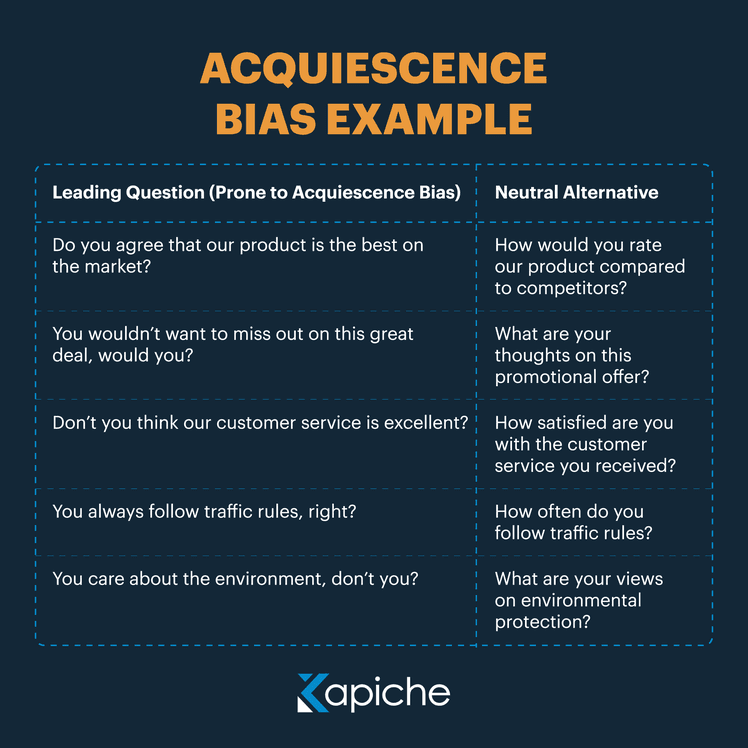
3) Extreme Responding Bias
Extreme response bias occurs when respondents consistently choose extreme options on a rating scale, such as always selecting "strongly agree" or "strongly disagree." This bias can be influenced by factors such as cultural background, personality traits, or the respondent's level of engagement with the survey.
Extreme response bias can lead to a distortion of the data, making it difficult to distinguish between respondents who genuinely hold strong opinions and those who are simply prone to selecting extreme options.
Extreme Responding Bias Example
For example, in a customer satisfaction survey using a Likert scale from 1 to 5, a respondent might consistently choose 1 (strongly disagree) or 5 (strongly agree) for all questions, even if their true opinions are more moderate. This can lead to skewed data that does not accurately reflect the overall sentiment of the population.
Minimizing Extreme Responding Bias
To address extreme response bias, researchers can:
Provide a range of response options: Use a wider range of response options, such as a 7-point scale instead of a 5-point scale
Include reverse-coded items: to help identify respondents who consistently select extreme options
Update question formats: Consider using alternative question formats, such as force-choice or ranking questions, that do not rely on rating scales
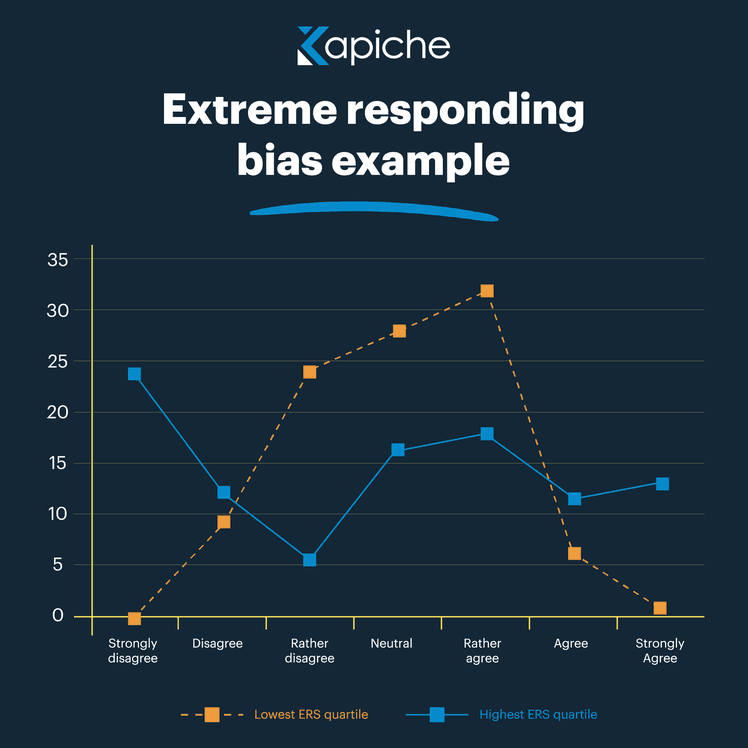
4) Courtesy Bias
Courtesy bias occurs when respondents provide answers they believe will please the researcher or avoid offending them, rather than expressing their true opinions. This bias often stems from a desire to be polite or to avoid conflict, leading to overly positive or neutral responses.
Courtesy Bias Example
For instance, in a customer feedback survey, a respondent might rate their experience as "excellent" even if they had some issues, simply to avoid giving negative feedback that might seem impolite or hurtful to the service provider.
Minimizing Courtesy Bias
Ensure Anonymity: Assure respondents that their answers are anonymous and cannot be traced back to them, reducing the pressure to provide socially acceptable responses.
Use Neutral Language: Frame questions in a neutral manner to avoid leading respondents towards positive answers.
Encourage Honest Feedback: Explicitly state the importance of honest feedback for improving services or products, emphasizing that negative feedback is valuable and appreciated.
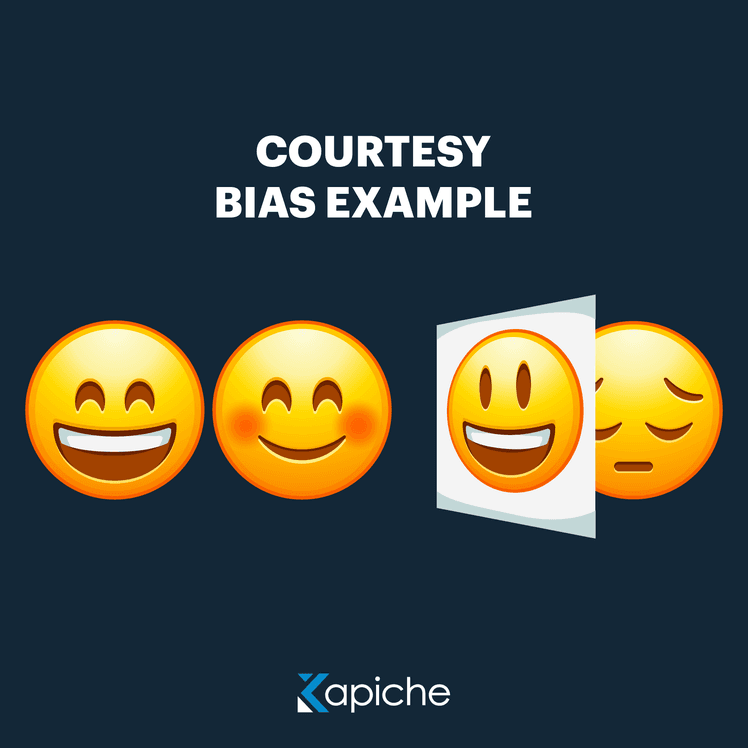
5) Question-Order Bias
Question-order bias, also known as order-effects bias, occurs when the sequence in which questions are presented influences respondents' answers. This bias can lead to skewed data as earlier questions may prime respondents, affecting their responses to subsequent questions.
Question-Order Bias Example
For example, if a survey asks respondents how satisfied they are with their overall life first, and then asks about their satisfaction with their job, the initial question may influence the response to the job satisfaction question. Conversely, if the job satisfaction question is asked first, it might set a context that affects the overall life satisfaction response.
Minimizing Question-Order Bias
To minimize question-order bias, researchers can:
Pre-test Surveys: Conduct a pre-test with a small group to identify any potential order effects and adjust the question sequence accordingly.
Randomize Question Order: Randomize the order of unrelated questions to prevent earlier questions from influencing later responses.
Group Related Questions: Group related questions together but randomize the order within these groups to reduce bias while maintaining logical flow.
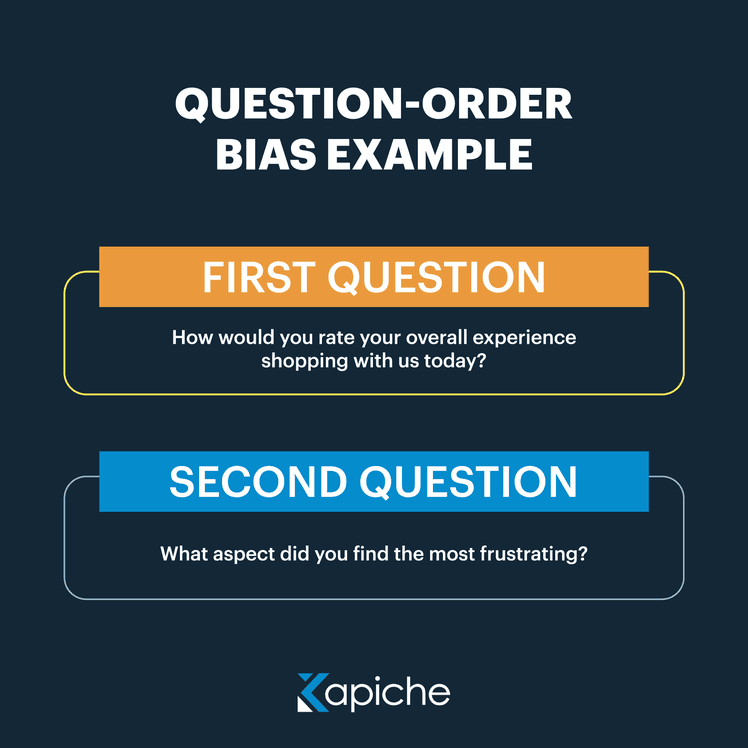
6) Demand Characteristics Bias
Demand characteristics bias occurs when respondents alter their behavior or responses based on their perceptions of the study's purpose or the researcher's expectations. This bias can lead to responses that are more aligned with what respondents believe the researcher wants to hear, rather than their true thoughts or feelings.
Demand Characteristics Bias Example
For instance, in a study about environmental behaviors, if respondents sense that the researcher is looking for pro-environmental attitudes, they might overstate their recycling habits or support for green initiatives, even if their actual behaviors are less environmentally friendly.
Minimizing Demand Characteristics Bias
To minimize demand characteristics bias, researchers can:
Employ blind surveys: Use single-blind or double-blind study designs where either the respondents, the researchers, or both are unaware of the specific hypotheses being tested.
Neutralize the researcher’s influence: Train interviewers to maintain a neutral demeanor and avoid giving any cues that might indicate the desired responses.
Use indirect questioning: Frame questions in a way that makes it less obvious what the researcher is looking for, such as asking about general behaviors rather than specific ones.
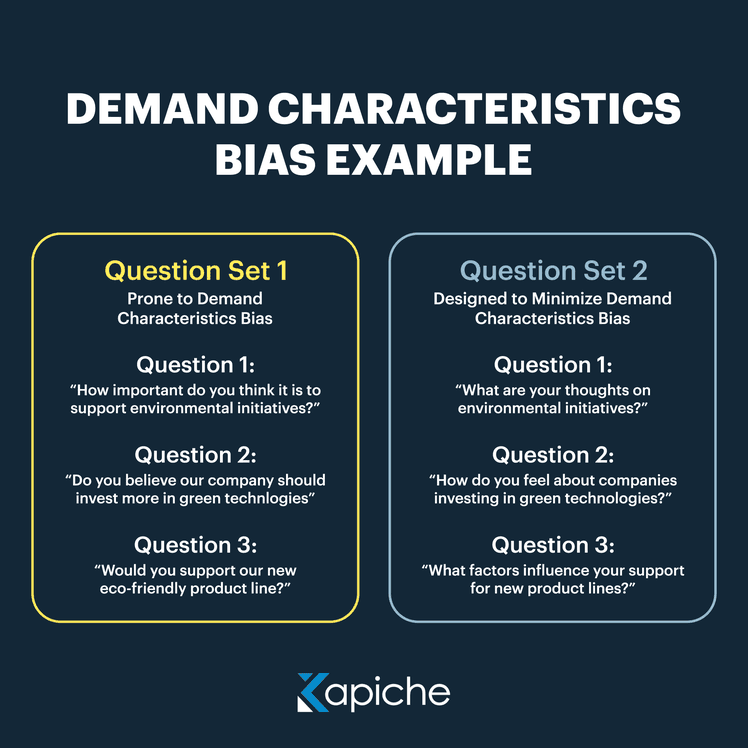
7) Wording Bias
Wording bias occurs when the phrasing of survey questions influences respondents' answers. This bias can lead to skewed data as the wording may suggest a particular response or make certain answers more appealing.
Wording Bias Example
For instance, a question like "How much do you agree with the statement that our product is the best on the market?" is likely to elicit more positive responses due to its leading nature. In contrast, a more neutrally worded question such as "How would you rate our product compared to others on the market?" allows for a wider range of responses.
Minimizing Wording Bias
To minimize wording bias, researchers can:
Use Neutral Language: Frame questions in a way that does not suggest a particular answer. Avoid emotionally charged or leading words.
Pre-test Questions: Conduct a pre-test with a small group to identify any potential wording issues and adjust the questions accordingly.
Provide Balanced Options: Ensure that response options are balanced and cover the full range of possible answers, including neutral and negative options.
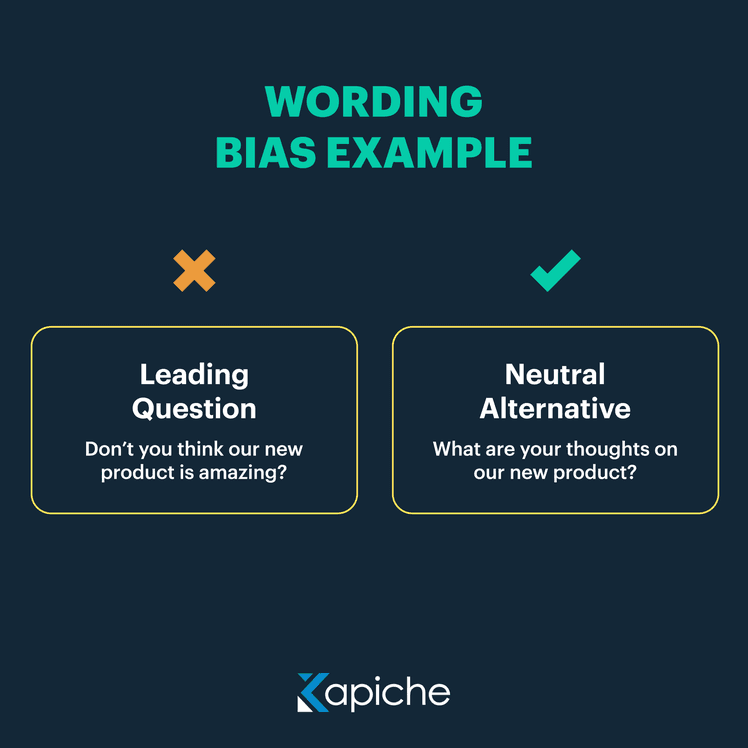
8) Primacy and Recency Bias
Primacy and recency bias occur when respondents are more likely to choose options presented at the beginning (primacy) or end (recency) of a list. This bias can lead to skewed data as the position of response options influences the choices made by respondents.
Primacy and Recency Bias Example
For example, in a multiple-choice question asking respondents to select their favorite brand from a list, options listed first or last are more likely to be chosen. If the list starts with "Brand A" and ends with "Brand Z," these brands might receive more selections simply due to their positions in the list, rather than their actual popularity.
Minimizing Primacy and Recency Bias
To minimize primacy and recency bias, researchers can:
Randomize Response Options: Randomize the order of response options for each respondent to ensure that no single option consistently benefits from a positional advantage.
Use Balanced Lists: When randomization is not possible, ensure that the list is balanced and that important options are not consistently placed at the beginning or end.
Limit List Length: Keep the number of response options manageable to reduce the cognitive load on respondents and minimize the impact of position effects.
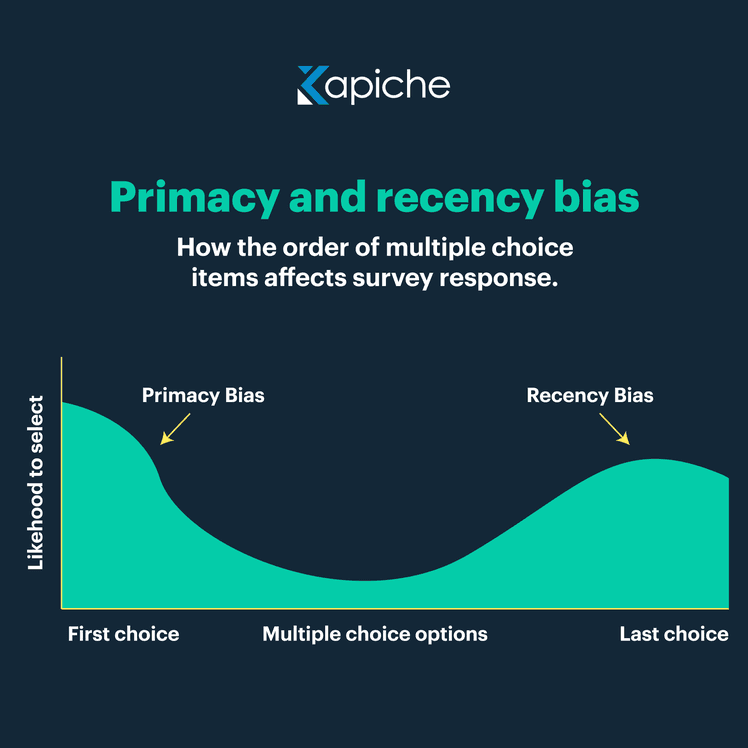
9) Non response Bias
Non response bias occurs when the individuals who choose to participate in a survey differ significantly from those who do not, leading to skewed results. This bias can arise when certain groups are underrepresented in the survey responses, affecting the overall accuracy and reliability of the data.
Non response Bias Example
For example, if a survey about workplace satisfaction is distributed via email and only a small percentage of employees respond, the results may not accurately reflect the sentiments of the entire workforce. Those who are dissatisfied might be less likely to respond, leading to an overly positive portrayal of workplace satisfaction.
Minimizing Non response Bias
To minimize non response bias, researchers can:
Increase Response Rates: Use multiple follow-up reminders and incentives to encourage participation from a broader range of respondents.
Simplify the Survey: Ensure that the survey is easy to complete and not overly time-consuming, which can help increase participation rates.
Diversify Distribution Channels: Distribute the survey through various channels (e.g., email, social media, in-person) to reach a wider audience.
10) Neutral response bias
Neutral response bias occurs when respondents consistently select the neutral or middle option on rating scales, regardless of their true opinions or experiences. This bias can lead to inaccurate data and a lack of meaningful insights. Causes of neutral response can both be survey-design related, and culturally related, where there are strong norms in place to avoid controversy.
Neutral Response Bias Example
For instance, in a customer satisfaction survey using a 5-point Likert scale (1 = Very Dissatisfied, 5 = Very Satisfied), a respondent might consistently choose the neutral option (3) for all questions, even if they had strong positive or negative experiences with the product or service.
Minimizing Neutral Response Bias
To minimize neutral response bias, researchers can:
Clarify Questions: Ensure that survey questions are clear, specific, and easy to understand, reducing the likelihood of respondents selecting neutral options due to confusion or ambiguity.
Randomize Scale Order: Randomize the order of positive and negative response options to prevent respondents from developing a pattern of selecting the middle option.
Limit Survey Length: Keep surveys concise to minimize respondent fatigue, which can contribute to neutral responding as a way to complete the survey quickly.
By identifying and understanding these various types of response bias, you can take steps to minimize their impact on survey results and ensure that the data collected is as accurate and reliable as possible.
For further reading on response bias and survey design, consider the following resources:
"Survey Research Methods" by Floyd J. Fowler Jr. (2013)
"The Psychology of Survey Response" by Roger Tourangeau, Lance J. Rips, and Kenneth Rasinski (2000)
Tips for Mitigating Response Bias
A carefully crafted survey question can significantly reduce response biases
Neutral language, balanced response options, and avoiding double-barreled questions are key strategies
Proper question wording ensures accurate and reliable survey data
Response bias is a common issue in survey design. There are a host of reasons why respondents provide inaccurate or misleading answers. The factors we've covered above are some of the most common ones. But other factors can include overall question wording, survey format, and respondent characteristics.
In addition to the tips we've shared above, here are some good rules of thumb to combat response bias across all your survey efforts. No matter what survey research methods you employ, these tips will help improve results.
1) Use Neutral Language
One of the most important strategies for minimizing response bias is to use neutral language when crafting a survey question. Leading questions that suggest a particular answer can significantly influence respondents' choices, resulting in biased data.
For example, instead of asking, "How satisfied are you with our exceptional service?" which implies that the service is already exceptional, a more neutral question would be, "How satisfied are you with our service?" This allows respondents to provide their honest opinions without being swayed by the question's wording.
Tips for Using Neutral Language
Avoid emotionally charged words or phrases that can influence responses
Use objective language that does not imply a desired answer
Have multiple people review questions to ensure neutrality
2) Provide Balanced Response Options
Another key strategy for reducing response bias is to provide balanced response options that cover the full range of possible answers. When response options are skewed towards a particular direction, respondents may feel compelled to choose an answer that does not accurately reflect their true opinions.
For instance, when using any kind of Likert scale to measure satisfaction, it is essential to include both positive and negative options, such as "Very Dissatisfied," "Dissatisfied," "Neutral," "Satisfied," and "Very Satisfied." This ensures that respondents have the opportunity to express their true feelings, rather than being forced to choose from a limited set of options.
Tips for Providing Balanced Response Options
Include an equal number of positive and negative response options
Offer a "Neutral" or "Not Applicable" option when appropriate
Avoid using extreme language in response options, such as "Extremely" or "Completely"
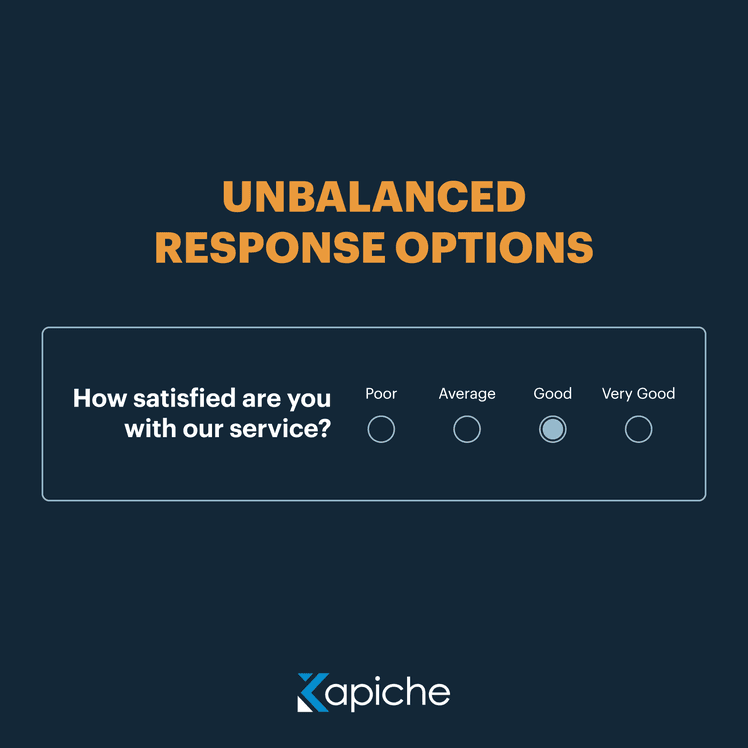
3) Avoid Double-Barrelled Questions
Double-barreled questions, which ask about two or more concepts in a single question, can lead to confusion and inaccurate responses. When respondents are faced with a question that addresses multiple issues, they may not know how to answer, leading to response bias.
For example, the question "How satisfied are you with the product quality and customer service?" should be split into two separate questions: "How satisfied are you with the product quality?" and "How satisfied are you with the customer service?" This allows respondents to provide clear and accurate answers for each concept.
Tips for Avoiding Double-Barreled Questions
Review each question to ensure it addresses only one concept
Break down complex questions into multiple, simple questions
Have colleagues or test respondents provide feedback on question clarity
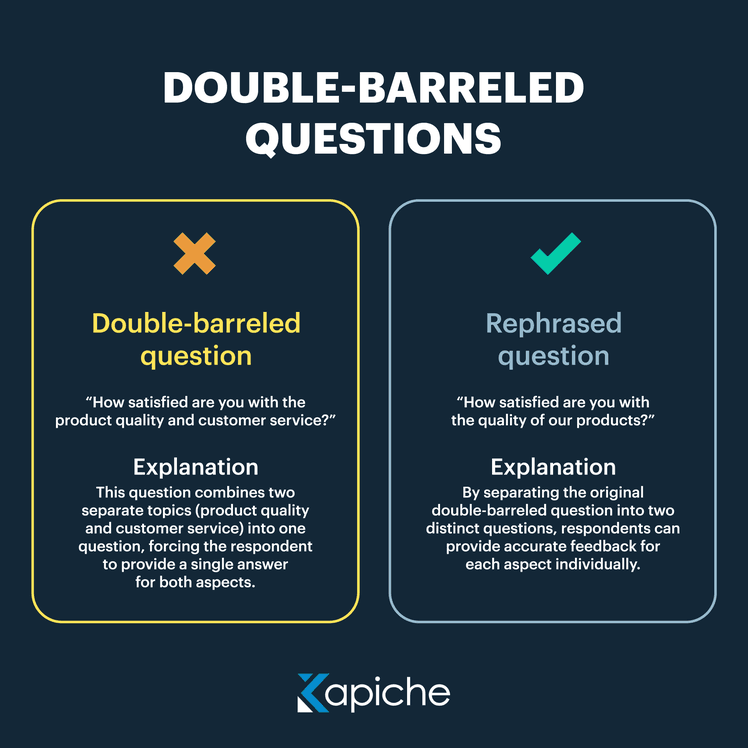
By implementing these strategies for effective question wording, researchers can significantly reduce response bias and obtain more accurate and reliable survey data. Neutral language, balanced response options, and avoiding double-barreled questions are essential tools for crafting surveys that yield meaningful insights.
4) Keep the Survey Length Reasonable
Respecting respondents' time and attention span is essential for maintaining engagement and reducing the likelihood of abandonment or rushed, inaccurate responses. Aim to create surveys that take no more than 10-15 minutes to complete, as longer surveys can lead to fatigue and disinterest.
To keep surveys concise, focus on the most critical questions that directly support your research objectives. Avoid asking for information that can be obtained through other means or that is not essential to your analysis. Additionally, consider using branching logic to display relevant questions based on previous answers, minimizing the number of questions presented to each respondent.
Monitoring Completion Rates
Regularly monitor survey completion rates to identify potential issues with length or complexity. If a significant portion of respondents are abandoning the survey at a specific point, consider:
Reviewing the wording and clarity of the questions leading up to the drop-off point
Assessing whether the preceding questions are necessary or if they can be streamlined
Providing a progress bar to give respondents a sense of how much of the survey remains
By keeping surveys focused and respecting respondents' time, you can improve completion rates and gather more accurate, representative data.
5) Foster Trust and Credibility
Building trust and credibility with respondents is crucial for encouraging honest and thoughtful responses. To foster a sense of trust for your data collection efforts, consider the following strategies:
Be transparent about how the collected data will be used and shared
Provide clear assurances regarding data privacy and security measures in place
Offer respondents the option to remain anonymous, particularly for sensitive topics
Follow through on any promised incentives or rewards in a timely manner
Additionally, sharing the survey results with participants demonstrates transparency and shows that their input is valued and acted upon. This can be done through a summary report, infographic, or personalized email, depending on the nature of the survey and the preferences of your target audience.
Communicating Results
When sharing survey results with respondents, keep the following points in mind:
Present the findings in a clear, concise, and visually engaging format
Highlight key takeaways and how the insights will be used to drive improvements
Express gratitude for their participation and the impact their feedback has had
Invite further engagement by providing a channel for additional questions or comments
By fostering trust and credibility throughout the survey process, organizations can build stronger relationships with their stakeholders and gather more accurate, actionable data.
Ready to take your data collection to the next level?
Understanding and mitigating response bias is crucial for obtaining accurate and reliable survey data. But identifying and addressing these biases can be challenging. That's where Kapiche comes in.
Kapiche is a powerful text analytics platform designed to help researchers analyze customer feedback, detect biases, and improve their survey efforts. With Kapiche, you can gain deeper insights into your survey data, identify patterns of bias, and make data-driven decisions to enhance the quality of your research.
Whether you're dealing with social desirability bias, acquiescence bias, or any other type of response bias, Kapiche provides the tools you need to ensure your data is as accurate and actionable as possible.
Watch an on-demand demo of Kapiche today.
FAQs
What is response vs non response bias?
Response bias occurs when respondents provide inaccurate, misleading, or incomplete answers to survey questions. This can happen for various reasons, such as social desirability bias (respondents answering in a way that makes them look better), acquiescence bias (respondents agreeing with statements regardless of their true beliefs), or extreme response bias (respondents consistently choosing the most extreme options).
Response bias can have a significant impact on the quality of the data collected. For example, if a survey about employee satisfaction is affected by social desirability bias, respondents may overstate their satisfaction levels, leading to an inaccurate representation of the workplace climate. This, in turn, can result in misguided decision-making by management.
What is an example of response bias?
An example of response bias is social desirability bias, where respondents answer questions in a way that they believe will be viewed favorably by others.
For instance, in a survey about alcohol consumption, respondents might underreport their drinking habits to avoid being judged negatively.
What causes response bias?
Response bias can be caused by several factors, including:
Question Wording: Leading or loaded questions can suggest a particular answer, influencing respondents to answer in a biased manner.
Survey Design: The order of questions (question-order bias) or the format of response options (e.g., Likert scales) can affect how respondents answer.
Social Desirability: Respondents may provide answers they believe are socially acceptable or favorable, rather than their true opinions (social desirability bias).
Acquiescence: Some respondents have a tendency to agree with statements regardless of their content (acquiescence bias).
Demand Characteristics: When respondents guess the purpose of the study, they may alter their responses to align with what they think the researcher wants to hear.
Survey Fatigue: Long or complex surveys can lead to respondent fatigue, causing them to choose neutral or random answers to complete the survey quickly.
Cultural Factors: Cultural norms and values can influence how respondents interpret and answer questions, leading to biases such as extreme responding or neutral responding.







